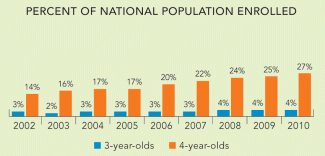
Early Education
The Power to Reduce Future Crime Victimization
July 29, 2011

While the goal of high-quality preschool programs is to ensure all young learners are ready to succeed in school, these programs are linked with a number of impressive long-term outcomes. Children who attend high-quality preschool are more likely to graduate from high school and go on to higher education than are their peers who did not attend. They are also less likely to require special education services or repeat a grade in school, both of which contribute to savings for taxpayers. Benefits extend well beyond reducing education costs. The societal and cultural improvement stemming from education reduces future crimes and future victimization. Students who attend these programs are less likely to become teenage parents, become dependent on welfare, and, notably, commit crimes as teenagers or adults. A recent study from the University of Minnesota found that, years later, participants in a high-quality preschool program had lower rates of incarceration and substance abuse than did their peers who were not enrolled. Deterring children from future crime benefits not only those individuals, but all those in society who may have become victims of crimes against person and property. Outcomes like this have triggered a wave of support for pre-K programs from groups ranging from Fight Crime: Invest in Kids to The Boys and Girls Club of America, among other organizations.

However, the long-term benefits of high-quality programs are being sacrificed for short-term savings during this economic downturn. As The State of Preschool 2010 found, states have reduced funding for pre-K programs while unemployment and falling wages have placed more children “at-risk” of involvement in delinquency and crime. In the 2009-2010 school year, state funding for these programs nationwide fell by nearly $30 million from the previous school year to about $5.4 billion, marking the first drop in total spending since NIEER began tracking. Spending per-child adjusted for inflation also has fallen by about $700 over the decade so that recent cuts add to a long-term unfavorable trend. Nationwide, at least 23 states fail to spend enough per child in their programs to meet the 10 quality benchmarks set by NIEER; another 10 state governments provide no funding at all for pre-K.
Trends have been better for availability of pre-K than for funding, but not what one might expect given the benefits. While access to state-funded preschool has increased over the last decade (see Figure 1 for details), we’ve seen slow growth in the percentage of 4-year-olds enrolled as well as a complete stagnation in 3-year-old enrollment in recent years. And, there is a wide variation among states in terms of pre-K access – ranging from 1.1 percent of 4-year-olds in Rhode Island to nearly 71 percent of 4-year-olds in Oklahoma. Far too many children are missing out on early learning opportunities that will have positive outcomes throughout their lives, including reducing the likelihood of serious crime, arrest, and incarceration as teenagers or adults.
Figure 1: Access to State-funded Pre-K, 2002 to 2010

Indeed, research indicates that between 35 and 45 percent of American students enter kindergarten not “school ready” — these are the students who can most benefit from the long-term academic and social benefits of pre-K. Some quick number crunching tells us that for an additional $1.7 billion, the nation could enroll all at-risk 4-year-olds in high-quality pre-K; another $5.8 billion would extend that opportunity to all at-risk 3-year-olds nationwide.
While taxpayers may pause at the price tag for state-funded pre-K programs, it is a small fraction of the costs our society pays for failing to start vulnerable children on the right foot. A 2007 study by Robert Lynch finds that high-quality pre-K for just the poorest 25 percent of 3- and 4-year-olds would result in $77 billion in annual decreased crime and child abuse costs by 2050.
Other research has pointed to similarly staggering figures regarding child abuse and neglect. The direct cost of child abuse and neglect in the United States totals more than $33 billion annually. The indirect costs of child abuse, including special education, mental health care, juvenile delinquency, lost productivity, and adult criminality, increase this total to more than $103 billion annually. While taxpayers might feel burdened by a $1.7 billion investment in at-risk 4-year-olds, this number seems insignificant compared to the $103 billion they will eventually spend on the results of lower education standards and the continued cycle of crime and abuse.
Likewise, reducing the number of both perpetrators and victims of crime is an important goal in American society. The criminal justice system, including incarceration, costs billions of dollars each year, to say nothing of the loss of life, property, and security experienced by too many victims each year. A report by Mission: Readiness reveals that criminal convictions contribute to the fact that 75 percent of America’s young adults are ineligible for military service. And, as recently noted by the National Center for Victims of Crime (NCVC), children are more likely than adults to be exposed to violence and crime, placing them directly in a vicious cycle with often disastrous results. As Mai said in a recent blog at The Crime Report, “Without the proper support to cope with their experience, young people are more likely to face, and cause, additional crimes in their own community.”
While even the highest quality preschool program cannot completely eradicate crime from our society, early interventions can significantly reduce the problem and better prepare the next generation for more productive, brighter futures. As a society, we have the resources to help young people avoid becoming victims and resist turning to crime. Protecting our children is an investment that cannot start too early.
– Steve Barnett, Co-Director, National Institute for Early Education Research (NIEER)
– Mai Fernandez, Executive Director, National Center for Victims of Crime (NCVC)
The Authors
W. Steven (Steve) Barnett is a Board of Governors Professor and the founder and Senior Co-Director of the National Institute for Early Education Research (NIEER) at Rutgers University. Dr. Barnett’s work primarily focuses on public policies regarding early childhood education, child care, and child development.
About NIEER
The National Institute for Early Education Research (NIEER) at the Graduate School of Education, Rutgers University, New Brunswick, NJ, conducts and disseminates independent research and analysis to inform early childhood education policy.

